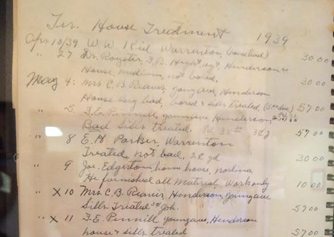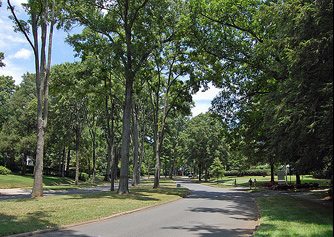Progression of Charlotte Pest Control Methods
From the 1930s up to the present day, the pest control industry has undergone significant change in the greater Charlotte region. Many chemicals and other methods used to eliminate rats, roaches, termites and other pests have evolved over the years and continue to progress thanks to non-stop research and advances in technology. Additionally, the increasingly environmentally-conscious mindset of Queen City residents has impacted how pests are controlled in homes and businesses throughout the area.
Let’s take a look at how pest control has changed around Charlotte over almost eight decades, and how Carolina Pest Management has stayed at the leading edge of the industry.
The Beginning of Carolina Pest Control in Charlotte
 Charlotte’s population was over 82 thousand in 1930 when the Great Depression hit the the United States. At roughly the same time, red fire ants made their way to America from Brazil, becoming entrenched in the southern US. Eventually fire ants worked their way north into the Charlotte region, and they remain a pest in our area to this day. One pesticide that people typically used beginning soon after World War II was Chlordane, a pesticide effective in eliminating fire ants and other pests in homes, gardens and on lawns. Arsenic and nicotine were commonly used as rat poison and roach bait at the time as well. Toward the end of the Great Depression, the economy rebounded enough to allow new businesses to open – one of which was Carolina Chemical and Pest Control, founded in 1939. David Dodd, Sr., a retired Methodist minister, saw a growing need for quality pest control in Charlotte, North Carolina and went into business with an acquaintance who owned a pest control truck, founding their company in Fuquay. The company set a very high standard in its industry, working hard to eliminate termites, roaches and rodents from homes and businesses. Dodd Sr.’s partner moved to Florida and in 1951, David Dodd Jr. assumed full control of the company and moved its headquarters to Monroe, NC.
Charlotte’s population was over 82 thousand in 1930 when the Great Depression hit the the United States. At roughly the same time, red fire ants made their way to America from Brazil, becoming entrenched in the southern US. Eventually fire ants worked their way north into the Charlotte region, and they remain a pest in our area to this day. One pesticide that people typically used beginning soon after World War II was Chlordane, a pesticide effective in eliminating fire ants and other pests in homes, gardens and on lawns. Arsenic and nicotine were commonly used as rat poison and roach bait at the time as well. Toward the end of the Great Depression, the economy rebounded enough to allow new businesses to open – one of which was Carolina Chemical and Pest Control, founded in 1939. David Dodd, Sr., a retired Methodist minister, saw a growing need for quality pest control in Charlotte, North Carolina and went into business with an acquaintance who owned a pest control truck, founding their company in Fuquay. The company set a very high standard in its industry, working hard to eliminate termites, roaches and rodents from homes and businesses. Dodd Sr.’s partner moved to Florida and in 1951, David Dodd Jr. assumed full control of the company and moved its headquarters to Monroe, NC.
New Roads Lead to New Visions in Pest Management
 During the latter part of the 1950s a strong focus on national infrastructure development led to the building of new roads in Charlotte, such as Independence Boulevard and I-85. This increased connectivity allowed the city to grow quickly and as the population rose, people found themselves in greater contact with unwelcome pests. The latter years of the 1950s brought a destructive insect to the southern United States: Formosan subterranean termites. In 1957, this species (native to southern China, Taiwan, and Japan) first appeared in Charleston, SC and soon spread to other states in the Southeast, eventually working its way into North Carolina. On the other hand, a good piece of pest related news from this period was the elimination of bed bugs in the United States through the use of pesticides. Unfortunately, a pesticide used at the time against bed bugs (DDT) was later found to be harmful to the environment and its use was discontinued in 1972. So, while bed bugs vanished from the country for a time, they eventually returned due to necessary changes in pest control methods in order to protect the environment. An increase in international travel and tourism also played a role in their reappearance. By 1960, Charlotte had grown to over 200 thousand people, more than doubling in size since 1930. Around this time, views on the use of Chlordane and other potentially environmentally toxic pest control products began to change; we began to realize that pest control practices must evolve so we could be better stewards of nature. In 1962, Rachel Carson’s book Silent Spring created a compelling, composited true story revolving around how some pesticides cause harm to wildlife, bees, domestic pets and humans. The release of this publication spurred a national environmental movement and further influenced public opinion about the safety of traditional pest control methods used in households and businesses – changes for the good of both nature and people had to be made. In response to this newfound information and elevated concern, Carolina Pest Management discontinued its use of Chlordane in the 1970s, almost 20 years ahead of the national ban on Chlordane in 1988. That early decision to halt its use of Chlordane foreshadowed Carolina Pest’s future focus on eco-conscious pest control methods. Today, Carolina Pest eliminates termites as often as possible by using eco-friendly baits which are less accessible to pets and are therefore “pet friendly”, while also using the safest effective liquid termiticides when required. Carolina Pest has long been at the forefront of using Green pest control practices when requested and where possible.
During the latter part of the 1950s a strong focus on national infrastructure development led to the building of new roads in Charlotte, such as Independence Boulevard and I-85. This increased connectivity allowed the city to grow quickly and as the population rose, people found themselves in greater contact with unwelcome pests. The latter years of the 1950s brought a destructive insect to the southern United States: Formosan subterranean termites. In 1957, this species (native to southern China, Taiwan, and Japan) first appeared in Charleston, SC and soon spread to other states in the Southeast, eventually working its way into North Carolina. On the other hand, a good piece of pest related news from this period was the elimination of bed bugs in the United States through the use of pesticides. Unfortunately, a pesticide used at the time against bed bugs (DDT) was later found to be harmful to the environment and its use was discontinued in 1972. So, while bed bugs vanished from the country for a time, they eventually returned due to necessary changes in pest control methods in order to protect the environment. An increase in international travel and tourism also played a role in their reappearance. By 1960, Charlotte had grown to over 200 thousand people, more than doubling in size since 1930. Around this time, views on the use of Chlordane and other potentially environmentally toxic pest control products began to change; we began to realize that pest control practices must evolve so we could be better stewards of nature. In 1962, Rachel Carson’s book Silent Spring created a compelling, composited true story revolving around how some pesticides cause harm to wildlife, bees, domestic pets and humans. The release of this publication spurred a national environmental movement and further influenced public opinion about the safety of traditional pest control methods used in households and businesses – changes for the good of both nature and people had to be made. In response to this newfound information and elevated concern, Carolina Pest Management discontinued its use of Chlordane in the 1970s, almost 20 years ahead of the national ban on Chlordane in 1988. That early decision to halt its use of Chlordane foreshadowed Carolina Pest’s future focus on eco-conscious pest control methods. Today, Carolina Pest eliminates termites as often as possible by using eco-friendly baits which are less accessible to pets and are therefore “pet friendly”, while also using the safest effective liquid termiticides when required. Carolina Pest has long been at the forefront of using Green pest control practices when requested and where possible.
Cankerworms and Green Pest Control Methods
 Charlotte’s population grew to 241 thousand in 1970, and later blossomed to over 314 thousand in 1980. As Chlordane was banned nationally in 1988, people continued to gravitate toward pest control methods that reduced the reliance on pesticides. Instead of rat poison, for example, they began to use screens, wires and caulk to exclude rodents from structures – common sense non-chemical methods played a greater role. They continued to use these and other mechanical methods to keep pests out. This philosophical shift was important to our region because in the 1980s, Charlotte became a leading destination for new businesses and a top city nationally for the finance industry. Population growth put much greater numbers of people and their property into close contact with regional pests, such as cankerworms. Cankerworms became a very destructive pest in Charlotte in the 1980s, removing leaves from trees, and particularly affecting the city’s beautiful willow oaks. This left trees more at risk to drought and disease. The Charlotte neighborhoods most affected by these cankerworms were (and still are today) Myers Park, Dilworth and Wilmore. Besides spraying in cankerworm infested areas, the city later came to emphasize tree banding, a mechanical method of managing pests which prevents cankerworms from laying eggs in the trees. Fortunately for Carolina Pest and its clients, in as early as 1972, the company had already begun refining its Integrated Pest Management methods and re-branded as Carolina Termite and Pest Control, Inc., reflecting their transition away from using harsh chemicals to remove pests in homes, businesses and gardens. Because of its reputation for effective and environmentally friendly practices, the company continued to expand its operations in Mecklenburg County and the surrounding area.
Charlotte’s population grew to 241 thousand in 1970, and later blossomed to over 314 thousand in 1980. As Chlordane was banned nationally in 1988, people continued to gravitate toward pest control methods that reduced the reliance on pesticides. Instead of rat poison, for example, they began to use screens, wires and caulk to exclude rodents from structures – common sense non-chemical methods played a greater role. They continued to use these and other mechanical methods to keep pests out. This philosophical shift was important to our region because in the 1980s, Charlotte became a leading destination for new businesses and a top city nationally for the finance industry. Population growth put much greater numbers of people and their property into close contact with regional pests, such as cankerworms. Cankerworms became a very destructive pest in Charlotte in the 1980s, removing leaves from trees, and particularly affecting the city’s beautiful willow oaks. This left trees more at risk to drought and disease. The Charlotte neighborhoods most affected by these cankerworms were (and still are today) Myers Park, Dilworth and Wilmore. Besides spraying in cankerworm infested areas, the city later came to emphasize tree banding, a mechanical method of managing pests which prevents cankerworms from laying eggs in the trees. Fortunately for Carolina Pest and its clients, in as early as 1972, the company had already begun refining its Integrated Pest Management methods and re-branded as Carolina Termite and Pest Control, Inc., reflecting their transition away from using harsh chemicals to remove pests in homes, businesses and gardens. Because of its reputation for effective and environmentally friendly practices, the company continued to expand its operations in Mecklenburg County and the surrounding area.
Environmental Stewardship and Pest Management Practices
 The population of Charlotte grew to 395,934 people in 1990 and 540,828 in 2000. With this population growth, invasive species of pests became more of an issue. One such invasive species is the Asian needle ant. There are over 170 species of this type of ant, scientific name Pachycondyla chinensis, in North Carolina and each of them have their own traits. People can identify this type of ant based on its clumsy climbing style. They are also noted for their itch inducing stings. Ouch! Carolina Pest continued to focus on the necessary balance between environmental stewardship and effective pest control as the years passed. In the late 90s, Carolina Termite and Pest Control, Inc. changed its name to Carolina Pest Management and began offering Green Services, an Eco-Friendly Pest Control Service that quickly became and remains in high demand with customers. Today in the green program, botanical-based products control many indoor and outdoor pests using plant oils as the active ingredients. These ingredients specifically pinpoint and block neurotransmitter receptor sites for octopamine, which are found only in invertebrates like insects. Mammals don’t have these receptors, so no harm will come to them even if they come in contact with the substance. By using these products, Carolina Pest is able to best find the balance between eliminating pests while also safeguarding the environment.
The population of Charlotte grew to 395,934 people in 1990 and 540,828 in 2000. With this population growth, invasive species of pests became more of an issue. One such invasive species is the Asian needle ant. There are over 170 species of this type of ant, scientific name Pachycondyla chinensis, in North Carolina and each of them have their own traits. People can identify this type of ant based on its clumsy climbing style. They are also noted for their itch inducing stings. Ouch! Carolina Pest continued to focus on the necessary balance between environmental stewardship and effective pest control as the years passed. In the late 90s, Carolina Termite and Pest Control, Inc. changed its name to Carolina Pest Management and began offering Green Services, an Eco-Friendly Pest Control Service that quickly became and remains in high demand with customers. Today in the green program, botanical-based products control many indoor and outdoor pests using plant oils as the active ingredients. These ingredients specifically pinpoint and block neurotransmitter receptor sites for octopamine, which are found only in invertebrates like insects. Mammals don’t have these receptors, so no harm will come to them even if they come in contact with the substance. By using these products, Carolina Pest is able to best find the balance between eliminating pests while also safeguarding the environment.
Mosquitoes Along With Other Pests Grow With Charlotte's Population
 The local population has increased significantly from where it was just a few decades ago – it breached 731 thousand in 2010. As the number of people throughout the area has grown, bed bugs and mosquitos have taken advantage of that growing human population and have risen in numbers as well. Bed bugs made their way back into the United States during the early 2000s and have become a significant problem for homes and businesses in the Charlotte region. This reestablishment is primarily due to an increase in travel to and from the city; bed bugs are very opportunistic in how they spread. In early to mid-2016, mosquitoes potentially carrying the Zika virus became a serious concern for many Americans, some of whom were bringing the virus back to North Carolina from endemic areas such as Puerto Rico and Brazil. In all, there have been 72 travel-related cases of the Zika virus in the state. Each of these pests mentioned require specific methods to control them. To combat bed bugs, Carolina Pest Management trains members of the company’s team in the best methods of eradication, making sure each person knew how to use the necessary products and methods against them. The company was also working on Charlotte mosquito control methods long before Zika- almost a decade ago- so once again, we were ahead of the curve.
The local population has increased significantly from where it was just a few decades ago – it breached 731 thousand in 2010. As the number of people throughout the area has grown, bed bugs and mosquitos have taken advantage of that growing human population and have risen in numbers as well. Bed bugs made their way back into the United States during the early 2000s and have become a significant problem for homes and businesses in the Charlotte region. This reestablishment is primarily due to an increase in travel to and from the city; bed bugs are very opportunistic in how they spread. In early to mid-2016, mosquitoes potentially carrying the Zika virus became a serious concern for many Americans, some of whom were bringing the virus back to North Carolina from endemic areas such as Puerto Rico and Brazil. In all, there have been 72 travel-related cases of the Zika virus in the state. Each of these pests mentioned require specific methods to control them. To combat bed bugs, Carolina Pest Management trains members of the company’s team in the best methods of eradication, making sure each person knew how to use the necessary products and methods against them. The company was also working on Charlotte mosquito control methods long before Zika- almost a decade ago- so once again, we were ahead of the curve.
Providing Effective Pest Control Solutions in the Carolinas Since 1939
The company’s accredited, highly-trained team, which is required to take continuing
education every year, continues to use the safest traditional pest control chemicals
along with natural, organic products against termites, roaches, rats and more. What
continues to set the company apart after 76 years is the knowledge and skill of its staff
and its commitment to the best customer service possible.
Request a Quote
We Can Help! Carolina Pest Management has been serving the Carolinas for four generations. We are one of the largest independently owned pest control companies in North Carolina. Whether you have Moisture Problems or Pest Control needs, we are here for you with decades of experience in handling these issues. Let us provide the security and comfort you and your family deserve. Contact us today!
Request a Quote